K.T. Katzmann's Blog: They're Here....
March 8, 2018
The Mysterious Monster: Nessie, Yeti, and That Time a Psychic Scanned Bigfoot

Few of the audience in my theater even blinked when Peter Graves turned up on screen in MIB 2. The venerable mission-assigner delivered some exposition in a hokey 70’s alien documentary ("Mysteries in History") with 70’s Doctor Who production values. Most of the theater shrugged. "Old stars need work," they probably thought. I knew better. I'd seen Mysterious Monsters.
I'd seen it lots of times.
So many times, in fact, that I'd memorized every commercial on a disintegrating videotape that I treated like a holy relic. So many times that I can still sing that jingle for the local Ford dealer jingle thirty years later.
After all, what was more thrilling to a young monster kid than a Bigfoot/Loch Ness Monster/Yeti documentary? Especially narrated in the dramatic tones of Peter Graves.

“Hi, I’m Peter Graves. I’d like to enroll at the University of Minnesota.”
“The facts we are going to present are true," Peter Graves declares that the beginning. "This may be the most startling film you'll ever see." I was hooked. Like many children, I haunted the 000.00 section of the library, where one of its subjects was labeled wonderfully at my local branch “controversial knowledge.” You find two types of subjects there: information technology or the Jersey Devil.
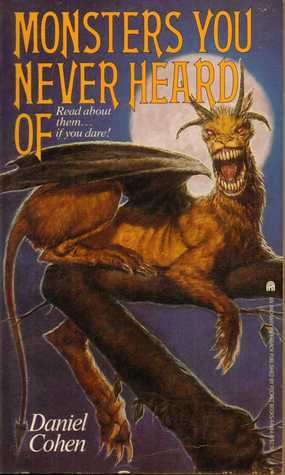
Speak of the Devil…
Man, I believed everything as a kid. That list of things Jeanine Melnitz rattles off in Ghostbusters? All of it. Hell, I did my 7th grade science project on pyramid power experiments from the Osborne World of the Unknown UFOs.

It was an interconnected world of weird we believer kids lived in, as intricate as any comic universe, which is why Peter Graves resonated with me. He had a Mission.
When the world was young, and the long POV shot of a guy grunting in an ape suit could still make us hold our breath, the Mysterious Monsters came to tell us that it was all true. With copious reenactment shots and some crazy methods, Peter Graves wanted all of us to believe. The show mostly focuses on Bigfoot, with the Yeti and the Loch Nessie Monster being the Marvel cameos of the film for us true believers.
It’s probably a familiar format to most of my readers. A breathy Graves introduces the mysteries of Bigfoot, Nessie, and Yeti before a slew of eyewitnesses and talking head scientists while camera-mugging reenactments do their level best to make us clap and say, “I do believe in cryptids!”
I’ll give them this; the used their travel budget. Graves rides helicopters over the Pacific Northwest, tromping through beautiful scenery to harangue expert after expert. There’s stunning Loch Ness footage, including gorgeous details of Urquat Castle, a place I still resolve to visit before I die. The interviews aren’t a slouch either, with such important names as Grover Krantz, Peter Byrne, and Tim Dinsdale, it’s a history lesson on early cryptozoology.
How are the monsters, you’re asking? The Bigfoot suit looks pretty good for low-budget 70’s; believe me, I’ve seen much worse cinematic fare from that time period. What stunned me was the variety of suits. You got the main Bigfoot, pictured above. You have the Yeti, with its interesting face suggesting a Fu Manchu mustache.
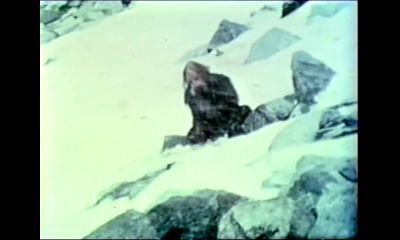
Then for family scenes, there’s more sasquatch suits, each slightly different.
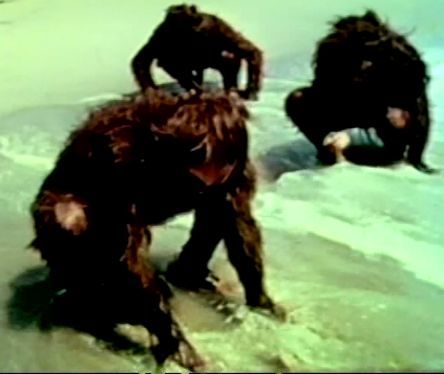
Trust me, from one schooled in the genre, I was not expecting this level of effort.
How’s their Loch Ness Monster? Nonexistent.
For paranormal films of this time period and well into the future, Nessie was a budget saver, a Lochtease. We cryptid kids hoped to see something cool, but every segment on the Scottish water was pretty similar. An ape suit was easy, but no move company that wallowed in budget mysticism would pop for the special effects needed to bring a plesiosaur to even subpar screen life.
You’d be lucky to get the Crater Lake Monster. Most of the time, you’d end up with the homicidal puppet from The Loch Ness Horror.
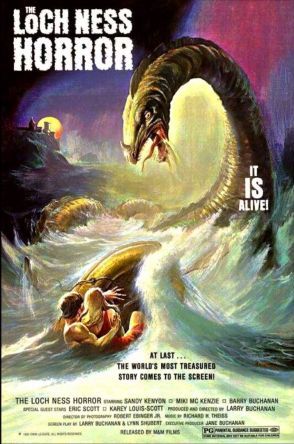
Trust me, the poster was the best part.
No, we would only be treated to the same old photographs and painting on the screen each time, and we'd like it.
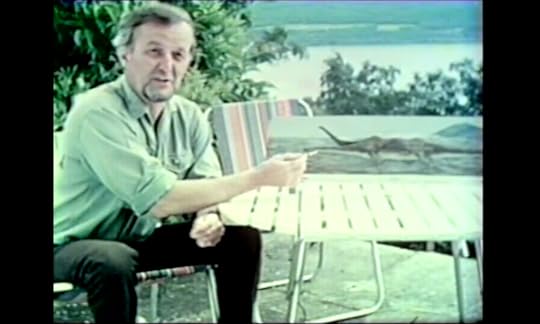
Tim swears the back can change shape. I’ve heard of X-Men with worse powers.
It’d be hard to match the spell-binding effect Nessie photos had with special effects anyway, especially with one only three years old at the time of filming.
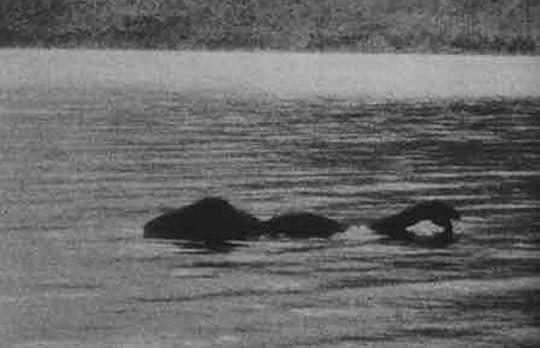
Nessie was the cryptozoological rock star who never comes out on stage. Bigfoot was the reliable opening band. I guess that makes Mothman that weird prog rock band whose concert you got high at once.
Also of note are the really fun graphics...
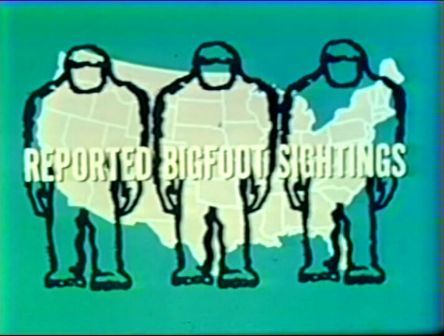
...and newspaper clippings the film throws up on screen.
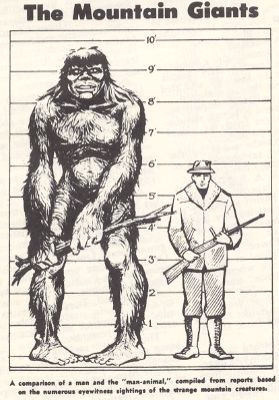
These kind of documentaries thrive on eye candy, and Mysterious Monsters has it in droves.
But this is early in the genre of paranormal documentaries, and therein lies the fun, because Peter Graves throws spaghetti at the wall and hits gold.
The first bit of weird science Peter Graves rolls out is voice analysis computers. Using supposed Bigfoot recordings, Peter is lectured by a nervous-seeming lab tech on the differences between human sounds and Bigfoot sounds.
Peter is just as enthralled as you will be.
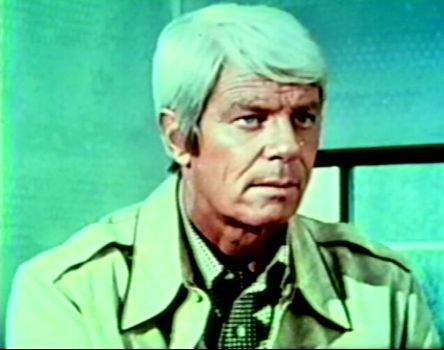
But then we get to the psychic.
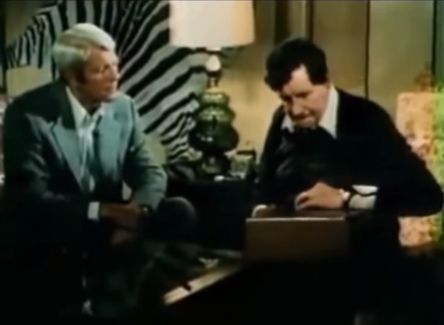
...or the 70's version of Antique Roadshow.
Peter Hurkos claimed to have psychic powers caused by a head injury after falling off a ladder, giving him a cooler origin story then 87% of all comics character created in the 1990s. He seems to be the second-rate Uri Gellar, never quite convincing quite as many people but adept at scoring international television specials. To sum up, if Uri Gellar is the Stephen King of psychics, Hurkos is Dean Koontz. But he claims to have psychometry, the ability to pick up your college t-shirt and know just how many disgusting things it’s touched.
With this in mind, Peter Graves takes a Bigfoot footprint in a wooden case and presents it to Hurkos without comment. Keeping the case close, Hurkos pontificates on the mysterious unknown object in the box. “It’s half-man, half-animal,” he says with the bored look of someone negotiating Turbo Tax. “Weighs about, I would say, 500 pounds. It’s about eight to nine feet.”
I have seen middle school kids in my literature class read aloud with more excitement. Hurkos finally gets rolling as he describe a cave-dwelling, long-armed gorilla-like carnivore. Finally, he draws a picture of the savage man-beast.
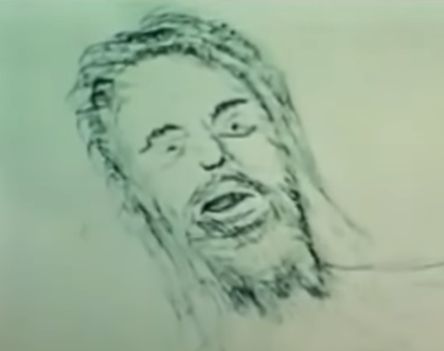
I think I've seen that Bigfoot before.

..as the best part of the Buffy movie, searching for the basement of the Alamo.
Peter claims that Hurkos has no idea what's in the box. Still, I do find it a little unlikely that Hurkos didn’t know the name or subject of the special he was being filmed for. I will admit that’s more common with paranormal documentaries, getting a specialist to pontificate with a fake title and recutting things to fit the narrative. Still, my skepticism is rising.
Afterwards, Mysterious Monsters never quite reaches the heights of weirdness. We get some senior citizens stomping through a recreation, finding Bigfoot footprints. Then, after an extended sequence of old man shouting happily about stride lengths, we come to the money shot, the part that lived in my dreams for years. When I thought of The Mysterious Monsters, I pictured The Attack.
Horror-movie-victim-to-be Rita Graham is chilling in her forest adjacent house, watching TV, enthralled by footage of men silently eating.
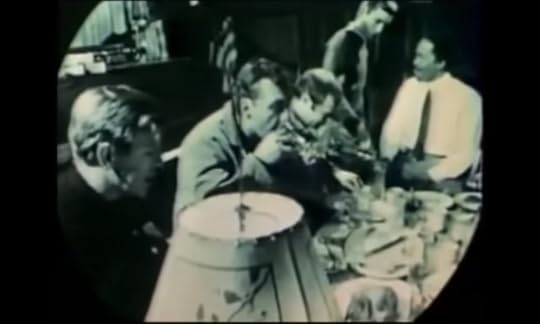
Seriously.
She hears noises outside, and as the men on TV loudly discuss margaritas, a large shadow moves quickly across the window behind her.
[image error]They learned too late that Bigfoot is a feeling creature, and because of it the greatest in the universe..
December 17, 2016
Got a Babadook Book, Book, Book
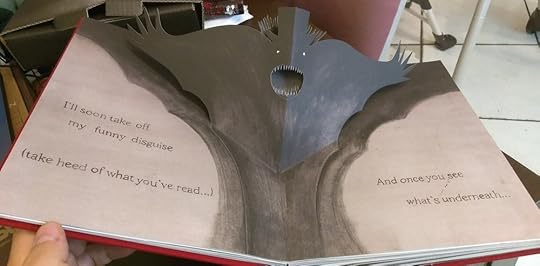
I’ve always loved tracking down movie replicas. My with just bought me a Lament Configuration Rubix Cube out of the blue because she thought it looked like something I should own. Books, though, those reproductions fill me with a particular glee.

Ghosts From Our Past filled me with glee as much asTobin’s Sprit Guide underwhelmed me. While I watched Paranormal Activity, I was overjoyed at the sight of the book Mica was reading. “That’s a Dover Publications cover,” I actually shouted. “I’ll bet my copy of The Complete Works of Charles Fort that I can track down that book!"
Now a king emerges above the rest.
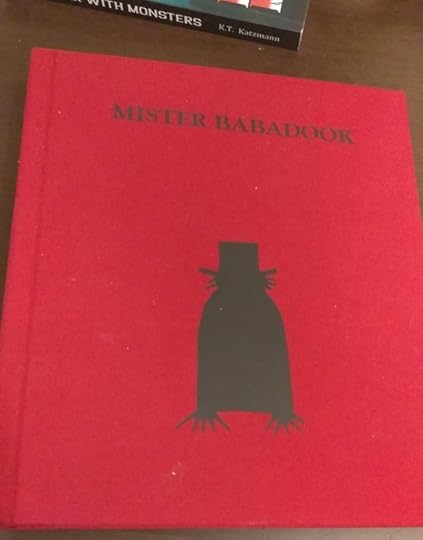
Dook. Dook. Dook.
I’ve written previously about how much I love the tale of family grief personified as the Boogeyman. It meant a lot to my family in a dark time for us. When I read that they were making a reproduction of the malevolent storybook from the film, my eyes lit up in glee. Hell, it wasn’t too expensive for the promised craftsmanship. I’ve paid almost much buying surprisingly bad video games on release day.
For months I had the same continual nightmare that the Cthulhu Wars Kickstarter gave me: mail theft. But then a note on my door warned me of my mailman's struggle to reach me, and I resigned myself to a long line at the post office. It was all worth it.
I opened it in the car and saw a strip of paper that proudly proclaimed that I had ordered and recieved a living nightmare. Putting the box on the seat next to me, I drove home. Ever remember being young and getting your mom's warning to open Transformers in the car? This was the grown-up version of that feeling.

I’ve kept the outer box as protection until I find a way to store it. With two children, this book has a nearly magnetic karmic pull of baby food and vomit.
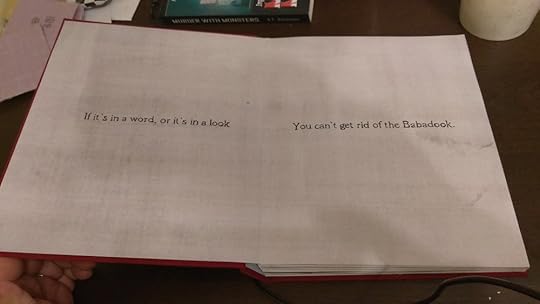
Yeah, I’ve learned that lesson. The book starts out with all the pages you saw in the movie. They’re brilliantly executed and beautifully drawn.
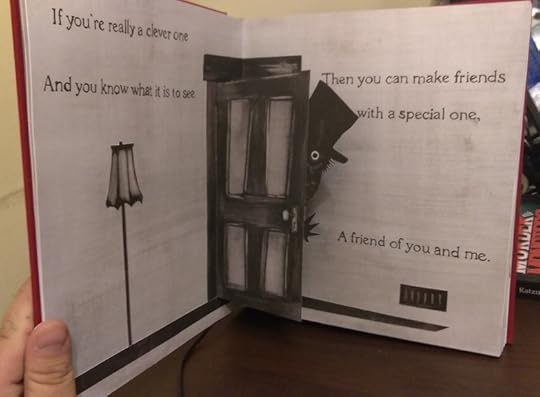
They drive me insane with worry. Here's construction details from other angles.
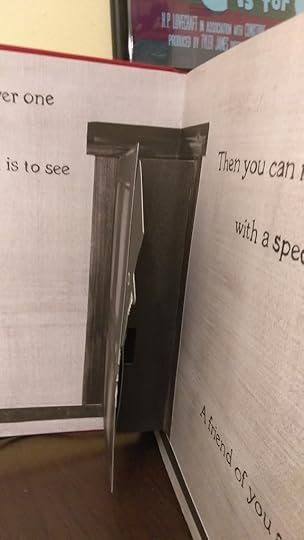
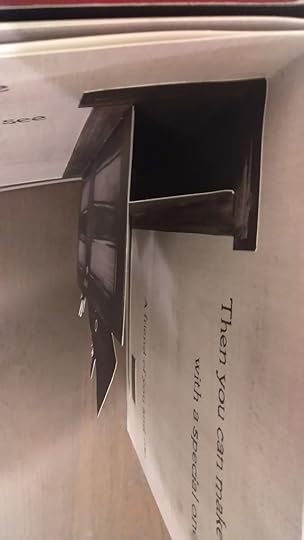
Seems study, but I have a toddler who loves pop-up books. I’ve seen too many destroyed to rest easy. I mean, I was terrified just trying to crack open this door . . .
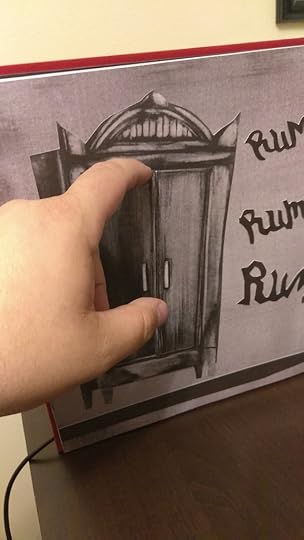
. . . yet somehow managed with turning the book into confetti.
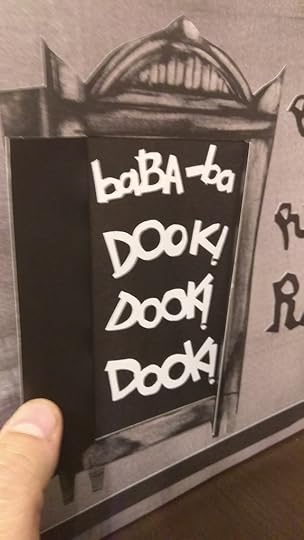
If the pictures don’t covey it well enough, every object on the pages is glued on instead of drawn. This nearly caused some early accidents.
Look at this thing.
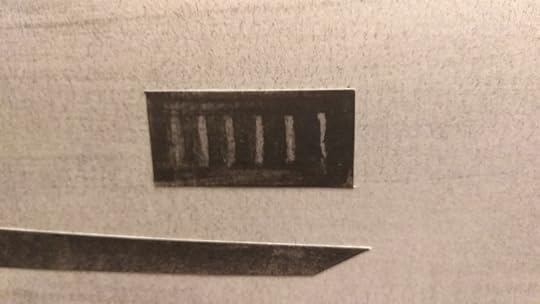
Is that a tab? A slidey-go? It’s raised, so I assumed it did something. Believe me, I’m so glad I didn’t push my luck with this presumably heating grate.
And I nearly wrecked these.
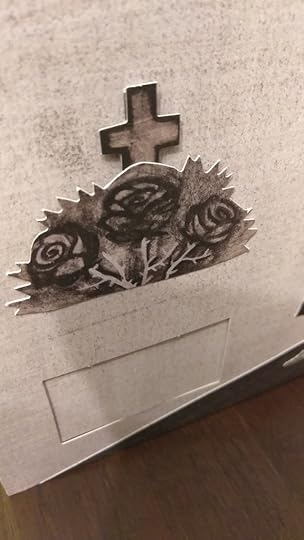
They look so . . . functional!
I'm not going to lay most of these pages flat any time soon. This is about how far I suspect the book should be opened for most pop-ups.
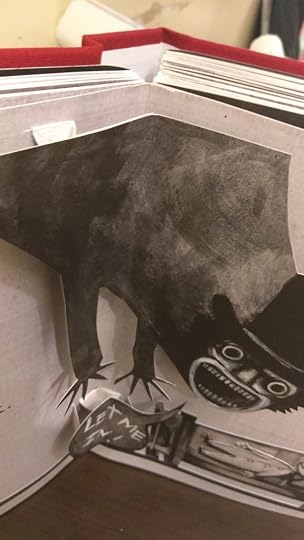
I think any wider an angle may rip something. I got this thought from the classic part where Mr. Babadook . . .
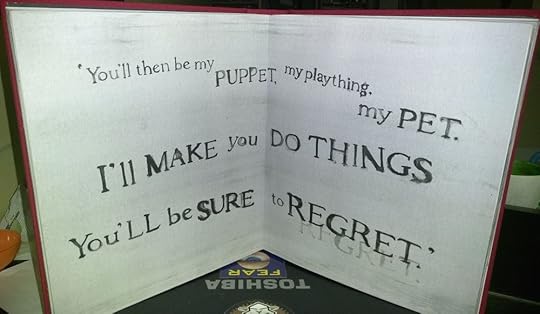
. . . brags about what he’ll force the reader to do.
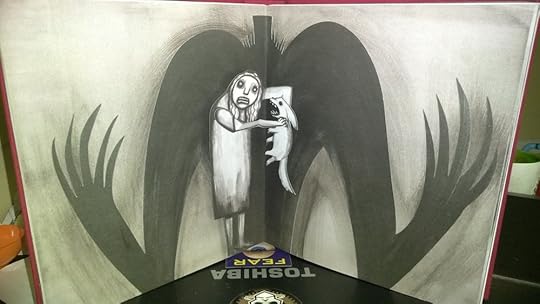
A chill grips my heart when I consider laying those pages flat on the table. That arm rips itself in half in my imagination.
I want to reiterate that all this terror comes from an adult ADHD sufferer’s paranoia about a new beloved possession. If I didn’t love this damn thing to death, I wouldn’t fret.
The truly beautiful thing about the reproduction job done here is that you get every pop-up from the movie . . . and then it continues.
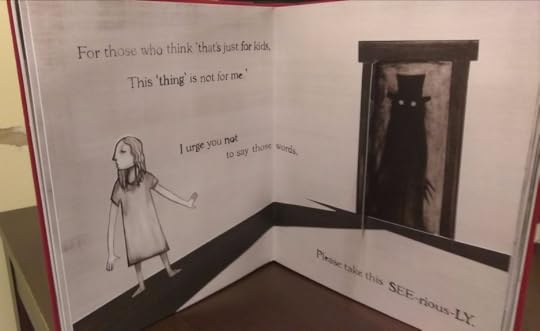
The book actually follows to the end of the movie while Mr. Babadook continues to narrate it! I love that wholeheartedly. Imagine being in the head of Jason Voorhees in the last minutes of a Friday the 13th film, just try. Think about how weird it would be for a monster to describe their film’s final confrontation in the first person tense. The out of the ordinary nature of The Babdook’s ending make it even more delightful.
I won’t reveal the ending, because it’s the frickin’ Babadook, and you really should watch it. I will say the real ending is this epic two page spread the ends the book.
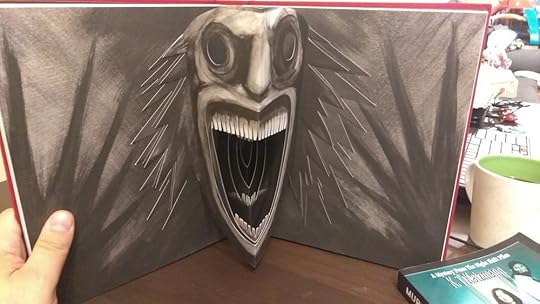
Mr. Babadook is a possession so lovely, so perfect in exceeding my expectations, that I fear to touch it in case I damage the damn thing. Totally worth the price tag.
To my knowledge, this was a singular print run. If you’re a horror fan who sees a copy available second hand for the price of one or two new video games, snap it up. It’ll fit snugly between your Handbook for the Recently Deceased and the Kandarian Book of the Dead.
Just don’t let your kids grab it. Seriously, I don’t know if it’s too scary, but children are tough on pop-up books.my daughter’s gone through two copies of the Jan Pienkowski pop-up classic Haunted House.
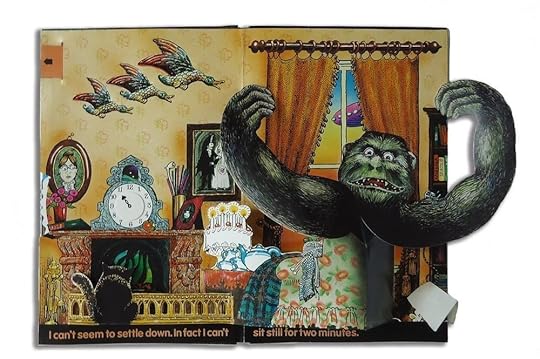
Now that’s a post waiting to happen.
October 18, 2016
A Child's First Cosmic Horror: Berkeley Square Number 50
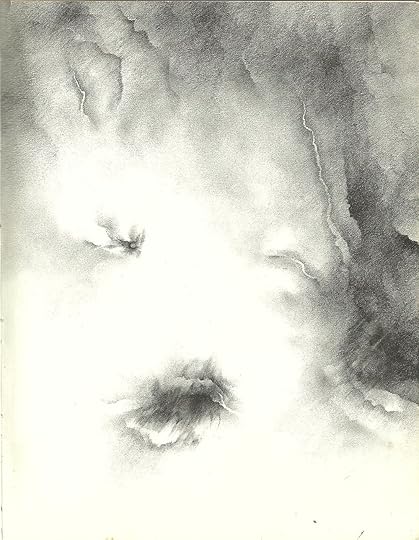
You may know that I love hunting down old monster books from my childhood. A chain of research has netted me quite the find. I think it’s the first taste I ever had of cosmic horror.
I made a Tumblr of Scary Stories to Tell in the Dark. That turned into tracking down the werewolf and vampire books that fear master Stephen Gammell had also illustrated. And, dear readers, it was exploring that series that returned a nightmare from my childhood to my hands.
The Eerie Series was dedicated to introducing kids to the mythology of monsters. There were plenty of other books that gave encyclopedic listings of movie plots, like the beloved Ian Thorne Monster Series from Crestwood House. The Eerie Series, however, used as many classical legends as possible. This was where, as I recall, I learned about wolfskin belts, the proper way to stake a vampire, and the werewolf fighting power of the simple apron.
Mildred Heavewater of Murder with Monsters has a thing about counting sesame seeds because of the Eerie series.
So I order the Ghosts volume and find the book that gave me nightmares. I had the hardcover burn itself into my memory . . .
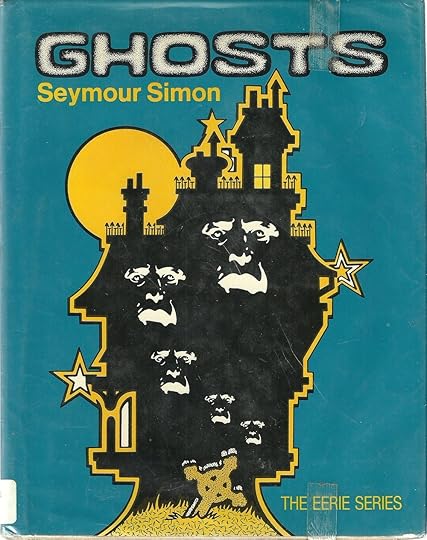
. . . but I also like the weird "Let the Buyer Beware" of the paperback.
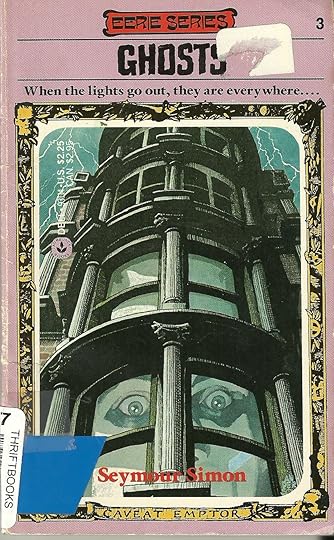
There’s a lot of classic ghosts stories and very faded photographs inside. Also, some wonderful Stephen Gammell art. That’s not important. What matters is the weird terror of chapter 2, “The Nameless Horror of Berkeley Square.”
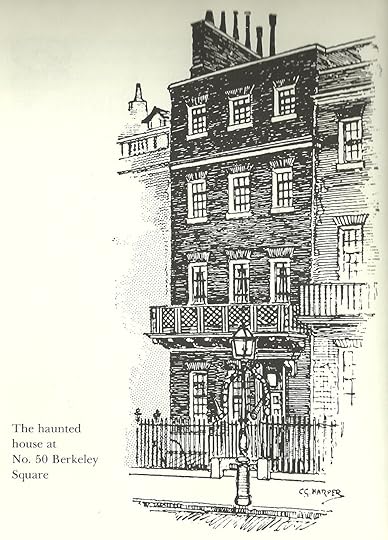
I’d been able to recite it from memory since I was seven. Memories of the inhuman illustration (seen above) haunted me. I’ve used Berkeley Square #50 in a Call of Cthulhu session! Worry started to well up within me: would the tale be as gruesome as I remember?
Hell, yes.
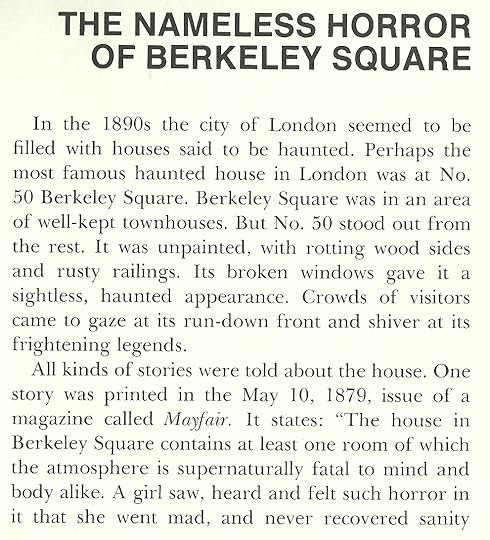
Madness. Not just fear or terror, but out and out madness. That grab’s an elementary schooler’s attention. Oh, it’s on.
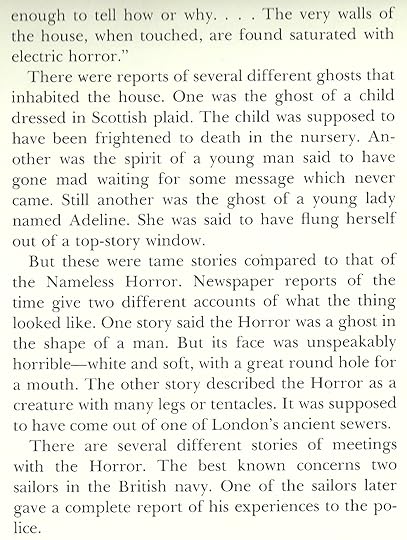
Ancient tentacled beings from within the Earth! This is so different than any other ghost story you could find in similar collections. The only tale that drips with almost the same amount of WTFery is the Annan Road appearances. I’ll have to give that one a write-up sometime.
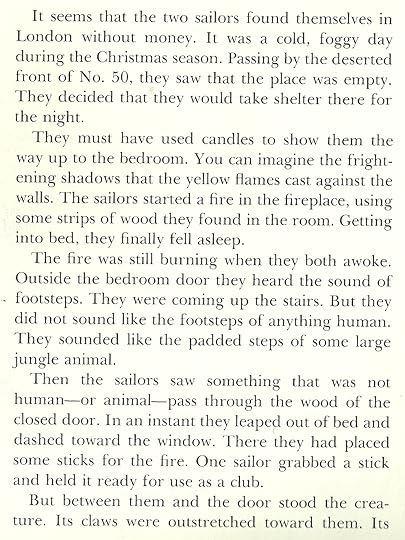
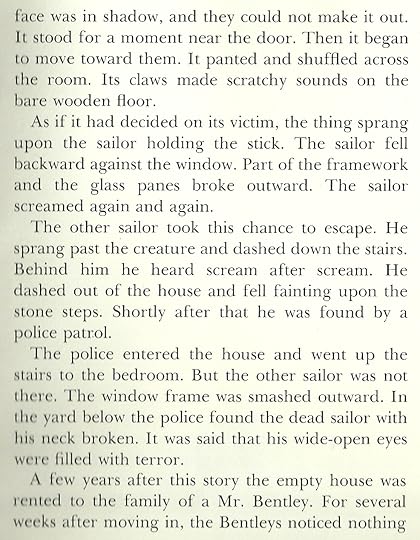
None of this is parsimonious. Nothing hangs together thematically, just a steady stream of scary weirdness. That randomness is more realistic, in a way, than a story with a more coherent theme crafted by a writer. It made the Horror tantalizingly plausible for young me. It's messy, the way real life is.
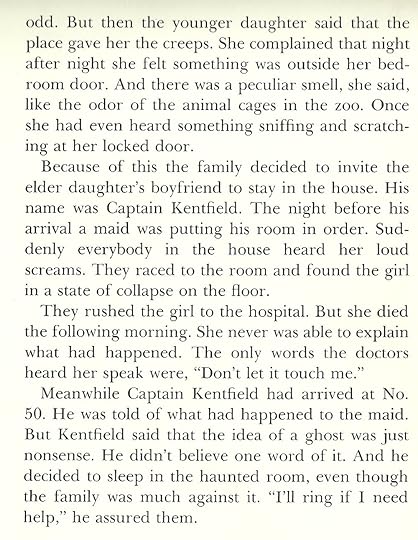
“Don’t let it touch me.” Brilliant. Less really is more.
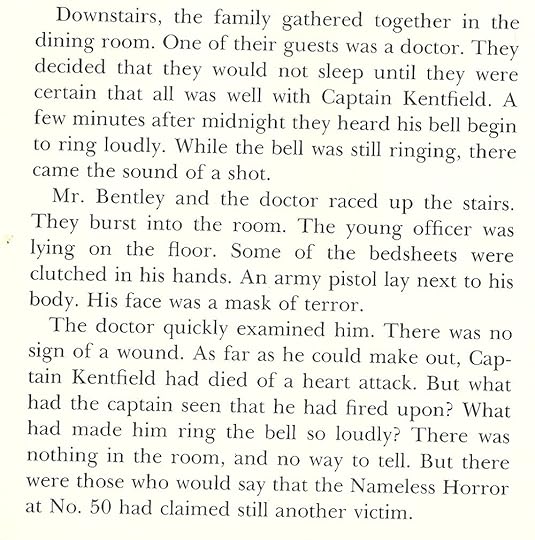
And that’s it. There’s no reveal, no italicized Lovecratian whammer or (as A Podcraft to the Curious wonderfully said) a Jamesian whallop. It’s still there, children, and it’ll kill you in weird ways. No wonder this became my favorite ghost story of all time.
Maybe it was exposure to this that made me appreciate Japanese ghosts. The onryo, the "vengeful spirits" of Ju-On and later The Grudge, work for me. I think Ju-On 2 was the only horror film to ever make me scream. After all, the pale apparition Kayako doesn’t leave clues or moan out messages. She kills you in unknown ways for reasons that she doesn’t care to explain. Matt Alt gives them a proper treatment in his excellent book Yurei Attack!, and he pulls no punches. These are ghosts as a force of nature, a hurricane in ectoplasm. Jacob Marley will give you exposition. These spooks want your jaw.
Apparently Berkeley Square Number 50 has been quiet, the hauntings coincidentally stopping after the end of yellow journalism. One wonders if the Daily Mail could stir up some spirits. Still, when my wife asked me I’d want to travel in the British Isles, there was only one place that belonged in the same sentence as Loch Ness.
Update!
My Lovecraft-meets-John-Carpenter’s-Thing story will see print soon in Alban Lake’s Miskatonic Nightmares! I had submitted it to their “Miskatonic Dreams’ anthology, but quickly got the response: “Nope. This goes in ‘Nightmares.’” Check it out!
July 6, 2016
Scary Stories to Tell in the Dark: The Walk

The Walk
Really, the art in this book works because it could be point of view shots. Before the right-handed story page even gives you any context, the reader first sees that gorgeous illustration. You look through a paper window into the misty forest and begin imagining.
For fun, I started brainstorming identities for the two figures before reading the actual story, and came up with both zombies or grave diggers before moving on. It’s just astounding how vague the picture is, and that’s a strength, not a criticism.
As opposed to the new version …
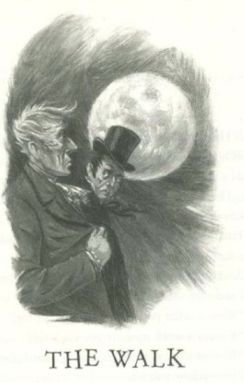
I read an opinion on the new version of the art for “The Walk” fails magnificently because it is dated. We look at it and assume the events are long past and harmless. The greatest master of the ghost story, M.R. James, said commented in “Ghosts: Treat Them Gently!” on the difficulty of scaring people with the archaic.
“Setting or environment, then, is to me a principal point, and the more readily appreciable the setting is to the ordinary reader the better.”
He notes that A Christmas Carol was intended as contemporary story as written, meaning that perhaps none of our continual cycle of Victorian adaptations may be as close to Dicken’s desired effect as Bill Murray’s Scrooged is.
If the world is wracked by a Fallout/Mad Max style apocalypse, some child centuries in the future whose found a nearly-disintegrated copy of Scary Stories to Tell in the Dark will still feel a chill run up their spine at that original art. Well, they will if they're not Fury Road’s Nux, who can’t identify a tree. The new art? “Oh. Older-timing folk before the before days.”
This art could be anywhere, and where the terror comes in.
As to the story …
A regular review blog works best when you have highs and lows. Those brave gentlemen over at the Post Atomic Horror Podcast watch all of Star Trek, and they often say the best shows they make are the ones where they consider both a diamond and a turd.
I’m honestly not sure how well the average nine year-old would be able to scare other kids using this script. It reads like a horror story by someone who knows of the existence of horror stories but has no experience with them and doesn’t know how to end one.
As to the reading, I received something of a jump when my cat rubbed against me through the blanket I had over my head. Wife is still successfully unaware of the program. I had to use my cell phone, lying phone on my stomach and holding the flashlight over the pages as I did while pouring over Sherlock Holmes stories past my bedtime in the late eighties.
Let me say this. That moment where I click on the flashlight and see that picture of her face on the cover of my treasury edition is still a creeptastic moment that gives me pause.
Next up is “What Do You Come For?” I note for the record that this is a hard run early on due to this chapter’s format. I can’t wait until we get to more traditional scary stories.
June 30, 2016
Stephen Gammell's Vampire Illustrations
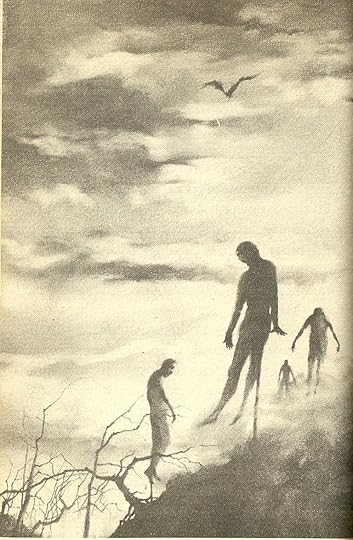
I’d just cracked open a copy of the Eerie Series’ s Meet The Vampire and received a pleasant (for me, that is) surprise inside. A decade before Scary Stories to Tell in the Dark, Stephen Gammell was already weaving nightmares. The picture above is from the Vlad the Impaler section, and it’s gorgeous. If it was in the better known SSTTITD series, I think it’d be regarded as one of his best.
Of course we need a general vampire …
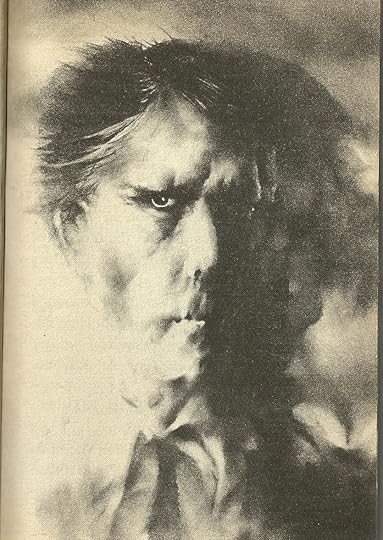
… some classic atmospheric vagueness with mist …
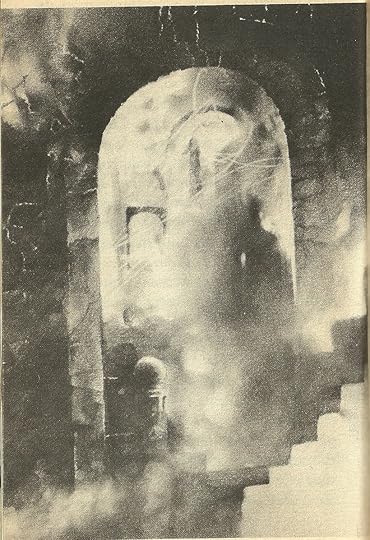
… the shapeshifting Mora of Slavic lore …

… a vampire escaping destruction by disintegrating into creatures of the night …
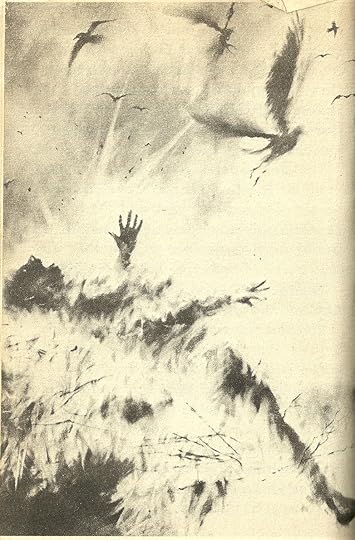
… and bats that are interesting, to say the least.
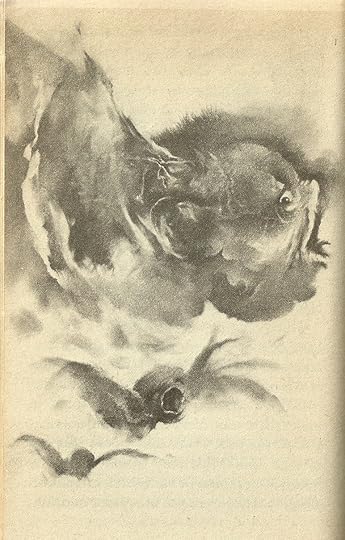
I have to hunt down the werewolf volumes to see if he’s illustrated that one too. I’m pretty sure he did the Witch one.
Expect a big post this weekend; I'm going to finish off this JUMP OUT AT THE AUDIENCE chapter in one rush to get closer to the things people are expecting . . . like her.
June 24, 2016
I Blog All of Scary Stories to Tell in the Dark. In the Dark. Part 1.
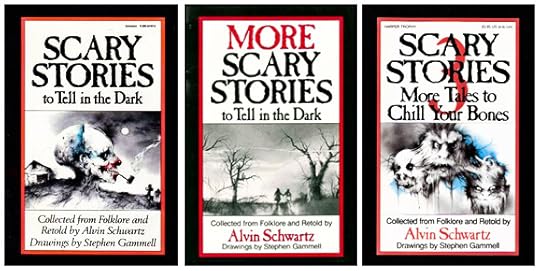
Part the First: Why The Hell Am I Doing This?
I would’ve been beaten for admitting this in elementary school, or at least shamed. I can hear the theoretical sounds of scorn and mocking laughter echoing throughout the crowded cafeteria in my head as I even consider typing this confession. Still, we can’t go forward without it, and I better get used to working through fear anyway.
I have never read any volume of Scary Stories to Tell in the Dark.

Blasphemy, right? Me, the guy who posts monster pictures, never read the defining horror books of a generation? How could I, of all people, miss out on one of the most defining fright books of my childhood?
As a kid, two things warred within my mind. Firstly, I loved monsters. Secondly, I was terrified of gore. Well, mostly the concept of gore. I didn’t accidentally change the channel to a Herschel Gordon Lewis marathon, or get traumatized by Jason or Freddy. The most terrifying thing I’d glimpsed was Large Marge from Pee Wee’s Big Adventure.

I was just an imaginative kid with ADHD; the gore in my head that I imagined inside those films kept me well away. Just the concept keep me awake at night. Like any good horror, it was the implications that terrified me.
How did that conflict work out? Well, mostly I found my refuge in Godzilla movies, 50’s sci-fi, and mythology. I checked out so many cryptozoology books and Crestwood Monster Series volumes at a time that the local library eased their maximum borrowing restriction for me. All those things were refreshingly safe.
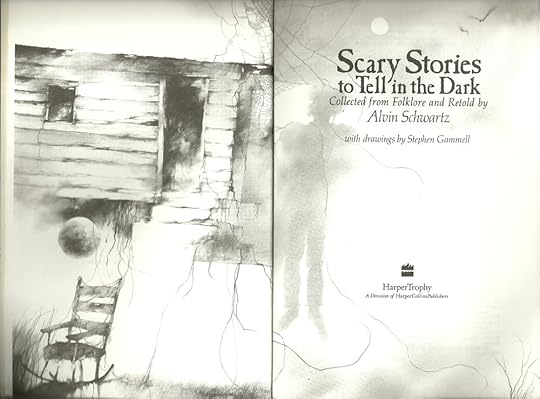
Somehow, this porch was terrifying.
I thus avoided the three Scary Stories books like the plague. I had no idea about the words inside, but I had seen some of those legendary pictures. Alvin Schwartz’s Scary Stories to Tell in the Dark is a series in three parts of freaky folklore from a wide variety of sources. Most people didn’t pick them up for the stories, though. SSTTITD hit the big time because of the detailed, expressive, nauseating artwork of Stephen Gammell, and I had caught a glimpse of those terrifying pictures.
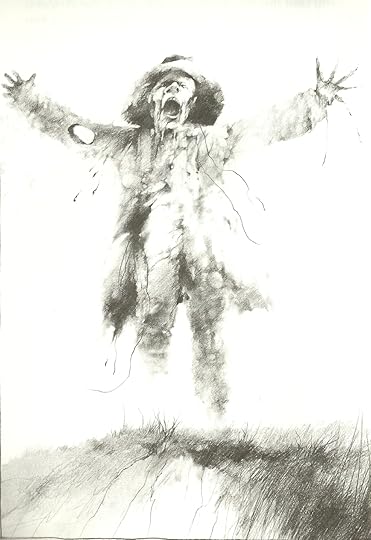
No way, I vowed back then. I’m never cracking open those things; I’d probably vomit within seconds.
I got better, though.
During my freshman year in high school, my friend decided to try shock therapy. “Sit down,” he said, cackling like an old man in a slasher flick. “I have something that will change your life.” Then we watched the first two Hellraiser films back to back.
And I saw, well, this. Click if you're prepared.
Okay, I naively thought, that’s as bad as it could possibly get. If that’s gore, I can handle it. Things like Cannibal Holocaust were not on my radar yet, you see.
But I never went back and read those books. A little Goosebumps, a lot of Lovecraft and King, but not SSTTITD.
It’s time to change that.
Part the Second: How the Hell Are you Going to Do This?
My stated goal with this blog is to read the stories in the way they were meant to be read. I, a grown-ass man, will walk into my darkened bedroom, sneak under my covers, and sit in a crouch while wielding a flashlight. I will probably annoy the hell out of my wife, who is completely ignorant of this part of my plan. I’ll let you all know what her reaction is.
Part the Third: Why the Hell Are Doing This?
Because people have been trying to ban these books for years. Decades after its publication, the American Library Association still had it on the most challenged list as of 2012. They may just be a documentary about them. If it’s bothered that many parents, terrified so children, and caused more arguments about different editions than fourth edition Dungeons & Dragons, I want to be in on the conversation and I have to go find a flashlight …
Next Time: A Big Toe. And an arm. Possibly a liver. Maybe a tail, too.
I Read Scary Stories: The Big Toe
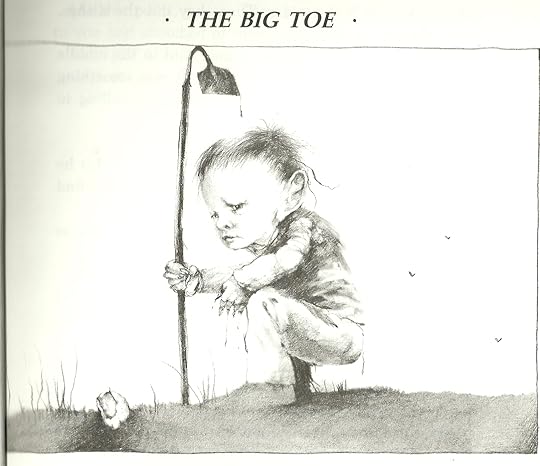
The Big Toe
. . . What the hell did I just read?
Our first tale opens with a boy discovering a toe sticking out of the ground in his family’s garden. He immediately pulls it off, hears something groan, and runs to present it to his family. The mom approves it as the Iron Chef ingredient for the night and throws it in the stew.
Hold on. I got questions.
Let’s get out of the way that eating a toe in stew is crazy. We know, that’s the obvious question, and we’ll move on past. Folk-tales are weird sometimes. Having your child hand you a piece of corpse and not asking where it came from is even weirder. The big question I want to know is, “Why wasn't this kid surprised to find a corpse buried in his garden?”
Seriously, it’s not like he found it in a strange far hill while scrounging for berries. This kid went out to work the garden and thought, “Hey, the corpse in the west field looks about ripe!” He wasn't even surprised, and neither were his folks.
Are these people really cannibal killers? It’d be pretty hard for anyone to bury someone in their garden without getting their attention, and bodies don’t bury themselves. We must conclude that little Junior’s gardening responsibilities include checking the murder victims to see if their ready to be soup yet. Is the kid our prospective victim or the tale’s true monster? Should we perhaps reserve that title for the psychopaths who taught him to eat human flesh?
Man, this story has so many levels.
In any case, something returns for the toe, moaning about his lost fleshy athletic equipment, and the junior cannibal listens to it smash through door after door, spouting “Where is my to-o-o-o-o-e?" until it finally wanders into his room, asks the $64,000 question . . .
And you jump at a nearby audience nearby as you scream, “You've got it!”
This section of stories is clearly labeled as the tales you tell to friends before pouncing at them. It’s a classic campfire story used to efficiently draw urine out of the bladders of the young. In fact, the structure of this one is downright familiar to me. I was spooked by one like this as a kid, one that I think had a better narrative hook than the cannibal family.

The Tailypo.
“The Tailypo” has roots in the Native American tales of Appalachia, where it was called the “Teh-Li Po.” The current version is probably influenced from a tale the Brothers Grim called “The Man from the Gallows” involving a liver instead of a toe. I was fond of this one as a kid because it had, of course, a monster.
In this version, a lone woodsman is starving after a long day of fruitless hunting. Right before he goes to bed, some unknown critter streaks across the bedroom floor. Our woodsman is a regular Davy Crockett outdoors-man ninja, and just as the thing runs into a hole in the wall he manages to toss a hatchet at the wall. The critter nearly gets away, but leaves a bloody tail behind.
Our hungry hero immediately fries the tail up and eats it.
Bad move.
Over the next few days, the man is stalked by the skittering unseen creature, who speaks in an inhuman voice, “Tailypo, tailypo, give me back my tailypo!”
The critter (usually referred to as the “Tailypo”), ignorant of the workings of the human digestive system, finally guts the man to look for his lost tailypo.
Optionally, the storyteller can mention then that the critter never found his tailypo, pause, and dp the whole “You've got it” leap at the audience as desired.
There’s a lot of Tailypo art online, and none of it is the one I grew up on. All the Tailypos I see are black . . .
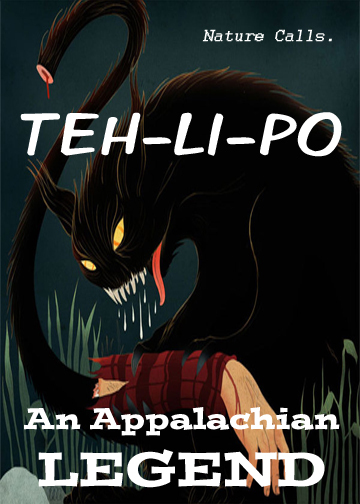
. . . and the kid’s book I read it from depicted it as a yellow wolf-thing.
Mark Twain told a similar story about a man stealing a golden arm from a grave, and I bet you can guess by now how that ends. He is very insistent on the where-fors of the telling. He said:
The pause is an exceedingly important feature in any kind of story, and a frequently recurring feature, too. It is a dainty thing, and delicate, and also uncertain and treacherous; for it must be exactly the right length -- no more and no less -- or it fails of its purpose and makes trouble. If the pause is too short the impressive point is passed, and the audience have had time to divine that a surprise is intended -- and then you can't surprise them, of course.
On the platform I used to tell a negro ghost story that had a pause in front of the snapper on the end, and that pause was the most important thing in the whole story. If I got it the right length precisely, I could spring the finishing ejaculation with effect enough to make some impressionable girl deliver a startled little yelp and jump out of her seat -- and that was what I was after.
But jumps aren't the only meaning here. Types of folktales are classified by the Aarne-Thompson system, a Dewey Decimal system for types of stories. These are type 366, where a corpse or mysterious animal won’t stop until they complete themselves again.
There’s a moral inside these, like most folk-tales or the urban legends they evolved into, a strong sense of “Don’t take what isn’t yours.” Still, I can’t quite fault the woodsman as much as the others. Dead man’s livers, big toes, and golden arms are a stretch too far, but fryin’ up critters is what mountain men do best. I think Tailypo taps into a slightly different vein of fear. It’s not being afraid of punishment; it’s the fear of learning that you’re in over your head with no way out.
As to the reading, I managed not to wake my wife. I crawled into bed while she was napping, pulled up the cover, and blew through the story relatively quickly. When she woke up, I asked her how her sleep was and only received the response, “Unconscious.” My wife has, of yet, no idea that I am crawling into bed to read scary stories with a flashlight. Not, admittedly, as creepy a thing as if I crawled into someone else’s bed to do it, but she might still be unnerved upon the discovery.
Or not. She’s my wife. She catches me doing a lot of weird stuff.
Next: The Walk
June 23, 2016
I Will Blog All of Scary Stories to Tell in the Dark

Part the First: Why The Hell Am I Doing This?
I would’ve been beaten for admitting this in elementary school, or at least shamed. I can hear the theoretical sounds of scorn and mocking laughter echoing throughout the crowded cafeteria in my head as I even consider typing this confession. Still, we can’t go forward without it, and I better get used to working through fear anyway.
I have never read any volume of Scary Stories to Tell in the Dark.

Blasphemy, right? Me, the guy who reviews monster books, never read the defining horror books of a generation? How could I, of all people, miss out on one of the most defining fright books of my childhood?
As a kid, two things warred within my mind. Firstly, I loved monsters. Secondly, I was terrified of gore. Well, mostly the concept of gore. I didn’t accidentally change the channel to a Herschel Gordon Lewis marathon, or get traumatized by Jason or Freddy. The most terrifying thing I’d glimpsed was Large Marge from Pee Wee’s Big Adventure.
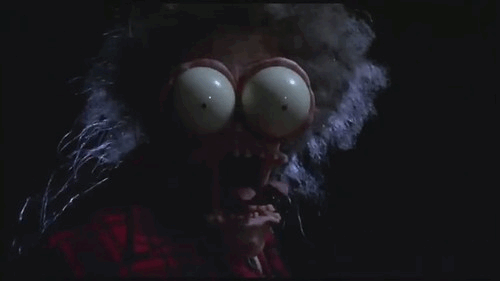
I was just an imaginative kid with ADHD; the gore in my head that I imagined inside those films kept me well away. Just the concept keep me awake at night. Like any good horror, it was the implications that terrified me.
How did that conflict work out? Well, mostly I found my refuge in Godzilla movies, 50’s sci-fi, and mythology. I checked out so many cryptozoology books and Crestwood Monster Series volumes at a time that the local library eased their maximum borrowing restriction for me. All those things were refreshingly safe.
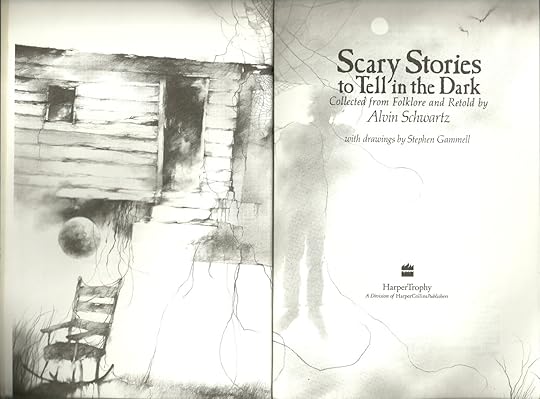
Somehow, this porch was terrifying.
I thus avoided the three Scary Stories books like the plague. I had no idea about the words inside, but I had seen some of those legendary pictures.
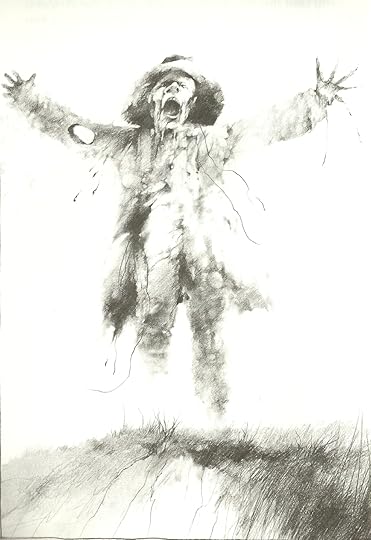
Alvin Schwartz’s Scary Stories to Tell in the Dark is a series in three parts of freaky folklore from a wide variety of sources. Most people didn’t pick them up for the stories, though. SSTTITD hit the big time because of the detailed, expressive, nauseating artwork of Stephen Gammell, and I had caught a glimpse of those terrifying pictures.
No way, I vowed back then. I’m never cracking open those things; I’d probably vomit within seconds.
I got better, though.
During my freshman year in high school, my friend decided to try shock therapy. “Sit down,” he said, cackling like an old man in a slasher flick. “I have something that will change your life.” Then we watched the first two Hellraiser films back to back.
And I saw . . . well, click here if you wanna know.
Okay, I naively thought, that’s as bad as it could possibly get. If that’s gore, I can handle it. Things like Cannibal Holocaust were not on my radar yet, you see.
But I never went back and read those books. A little Goosebumps, a lot of Lovecraft and King, but not SSTTITD.
It’s time to change that.
Part the Second: How the Hell Are you Going to Do This?
My stated goal with this blog series is to read the stories in the way they were meant to be read. I, a grown-ass man, will walk into my darkened bedroom, sneak under my covers, and sit in a crouch while wielding a flashlight. I will probably annoy the hell out of my wife, who is completely ignorant of this part of my plan. I’ll let you all know what her reaction is.
Part the Third: Why the Hell Are Doing This?
Because people have been trying to ban these books for years. Decades after its publication, the American Library Association still had it on the most challenged list as of 2012. They may just be a documentary about them. If it’s bothered that many parents, terrified so children, and caused more arguments about different editions than fourth edition Dungeons & Dragons, I want to be in on the conversation. I have to go find a flashlight …
Next Time: A Big Toe. And an arm. Possibly a liver. Maybe a tail, too.
June 16, 2016
Golems & Bagels: I Have a Kickstarter!
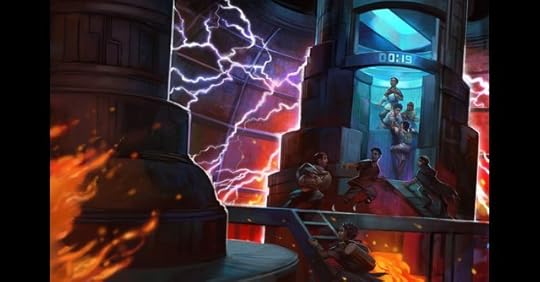
I research a lot as a writer. Vampires. Golems. Sasquatch.
The thing I've researched the most? Bagels.
The publisher Crossed Genres launched "Hidden Youth," an anthology focusing on fantasy and disadvantaged youth. I was raring to go! I wanted to do something involving chimney sweeps base on the craziness in Dirty Old London.
Then . . . the bagel.
I found Maria Balinska's excellent book on bagels, grabbing it off a library shelf on a lark and found what I needed. Inside The Bagel: The Surprising History Of A Modest Bread, I found the plight of the downtrodden Polish street bagel vendor child.
But I'm K.T. Katzmann, so I added golems.
Bagels. Golems. A bagel golem? Maybe . . .
Want to read it?
Here's the Kickstarter! Pledge here!
Look at how much praise their previous books have!
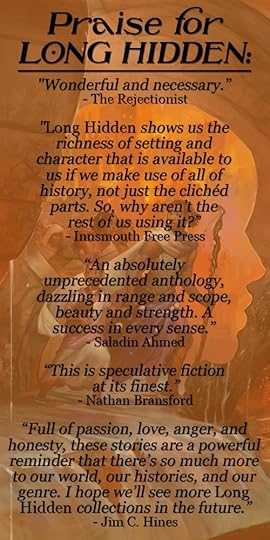
Here are the stories!
Jaymee Goh - A Name to Ashes
A.J. Odasso - Feet of Clay
Thom Dunn - An Baile Na Mban
Alec Austin - The Paper Sword
Warren Bull - Crossing the Line
De Ana Jones - Fear of the Dark
Michael Ezell - Genius Jones and the Rolling Rifle
E.C. Myers - In His Own Image
Erik Jensen - How I Saved Athens From the Stone Monsters (I want to know how!)
Imani Josey - North
Kate McCane - Nelly
Momtaza Mehri - The Jinn’s Only Son
Peter Medeiros - Acclimating Fever
Skin Brewer - Not A Witch
J.S. Hawthorne - The Promised Land
Nitra Wisdom - Purple Wings
P. Djeli Clark - The Mouser of Peter the Great
Camilla Zhang - The Ship That Brings You Home
K.T. Katzmann - The Bread-Thing In the Basket (That's me!)
Jessi Cole Jackson - Throwaway Children
Sioban Krzywicki - Trenches
JM Templet - The Ostrich Egg Girl
If you liked my story "Sam, Sam, and the Demoness" in Ain't Superstitious, you'll love this one.
Pledge to the Kickstarter, because a good anthology is like a bagel: sometimes, you want one with a little of everything.
May 10, 2016
The Knife, the Library, and the Green Car
I take a knife to my library sometimes. Don’t worry, I only do it after hours.
You may be backing away at this point, so I’ll back up.
I live in a point in Florida where rural meets suburb. Within twenty minutes of my house is a sports stadium and casino. Within five, you can see horses ridden on city streets. Given that, there’s always a bunch of creepy Everglades-and-mist roads to transverse. The eeriest one was renovated just after my scariest night ever, where I had to call and apologize to 911 while things went down. More on that someday. The current creepiest one holds my local library.
It’s a small branch, near a horse farm, a pub, and enough trees to advance on MacBeth’s real estate. There’s no good reason to go there at night unless you’re as forgetful as me.
If you’re that absent-minded, you may realize that you have library books due long after you’ve put the kids to bed. “Oh, crap,” you think, “how many of DVDs are supposed to have gone back today? Those are expensive.” Thus, you gather up your materials for a midnight drop-slot run. After all, drop-slot returns count as being given in a day early, and fines can otherwise add up.
My problem is that I write horror fiction. I only get paid for fantasy currently, but that’s a matter of time and a tangent in any case. Stick me on a lonely path surrounded by woods, out of view of the main roads, and my imagination will start to eat itself. It doesn’t matter if I’m within one minute driving distance of a lit supermarket plaza; all I can see around me is a backdrop to shoot the next Swamp Thing movie in.
The knife comes along with me. It made my acquaintance when I borrowed my Dad’s car. The wheel went flat, but all I found in the trunk was Justin Bieber lamps, 70’s porn, an absence of automotive tools, and the little knife. My father is a classic get-rich-quick schemer, and packs his vehicle with accordingly random objects. The knife looked like it could be useful.
And I wouldn’t even bring it if it wasn’t for the Green Car.
Logically, I know there’s no creatures hiding in the forest. I’ll even grant you that the likelihood of encountering homicidal drifters is nearly insignificant. No, what sets my imagination afire is the Green Car. Come midnight, the only things in the parking lot are myself and the drop-slots on one end and the parked car on the far, darkened side other of the parking lot.
Now, I know intellectually that there’s lots of potential explanations for its presence. Someone in the neighborhood has a small driveway, or carpools home perhaps. I don’t know. Lots of things are more realistic that “They’re in there, watching me.”
But I am descended from tens of thousands of years of cagey bastards who assumed that predators were nearby, so I look askance at the tinted windows and wonder if someone’s looking back. Part of my brain’s wired to obsess over predators, and most of the time I let it exercise in its cage by writing about monsters, but every so often it rattles the bars and screams mostly empty warnings.
I could, I know, just drive by the silent, shadowed car. Flash my brights, see if anyone’s there. Odds are that the worst I’ll do is stir some poor homeless family sleeping in their safe parking spot. Still, the predator radar part of my brain doesn’t care about odds.
Thus, there you’ll find me, tiny little fishing knife in one hand, Darth Vader bag in the other, stuffing graphic novels and DVDs into the drop-slot while I look over my shoulder and keep an eye on my very close and still running car with its door unlocked.
The Green Car is Stephen King. It’s Richard Matheson. It’s the slightly outer in the normal, the thing that starts you wondering where reality keeps its teeth and how sharp they are. It’s the mystery that you fear to solve.
And sometimes, just sometimes, it’s worth a quarter a day per book not to deal with it. Other times, though, I wonder if I’d miss it. After all, everyone loves a hint of the mysterious. Twenty minutes of chilling atmosphere is an inspiring thing for a writer.
But I think I’ll stop by the library on my way home tomorrow. I got books coming due soon.
They're Here....

Few things are as cool as a crate of your own books arriving. Don't forget, the giveaway starts in two days and ends on Devil's Night!

Few things are as cool as a crate of your own books arriving. Don't forget, the giveaway starts in two days and ends on Devil's Night! ...more
- K.T. Katzmann's profile
- 106 followers



